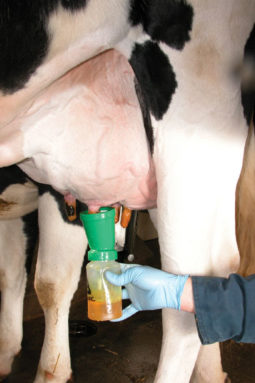As the days get shorter and the temperatures begin to flirt with freezing, it is time to start thinking about proper teat dip management for cold weather. In fact, any dairyman who faces cold, wet and windy conditions, whether in New Mexico or Wisconsin, needs to address general teat condition when temperatures fall. It is important to continue an efficient teat dip program on the farm to aid in mastitis control during cold weather, but you also need to take precautions to avoid cold weather effects on the dairy cow’s mammary system.
Dairy producers in the northern portions of the United States may think that when the weather drops below freezing they can eliminate the post dip practice on their farm. While this may work because the freezing temperatures decrease the growth of most bacteria on farms, it has been shown that by completely eliminating the teat dip practice, the spread of contagious mastitis has increased on farms.
At temperatures above 20 degrees Fahrenheit, a conditioning pre/post teat dip should be used. Designed toimprove overall teat skin condition, a conditioning pre/post teat dip will improve teat end health by reducing symptoms of hyperkeratosis. The symptoms tend to proliferate in cold, dry weather and can also be a result of milking machine factors, parity and weather. Nevertheless, healthy teat ends reduce the potential of bacteria penetrating the teat canel, which continues to be a growing issue as production and parlor throughput is pushed.

At temperatures below 20 degrees, producers should consider switching to a high emollient cold weather teat dip, instead of discontinuing teat dipping during the cold weather months. A high emollient cold weather teat dip is designed to protect cow’s teats during inclement weather while conditioning the teats for better overall udder health. Currently every major manufacturer of teat dips has a “cold weather teat dip” butfew have an effective conditioning pre/post teat dip.
(See Figure 1 at left)
Storage
Not only do producers need to be aware of the exposure cows face following milking they need to take into account how storage of teat dip in cold weather can decrease its effectiveness. According to Jeffrey Reneau, Department of Animal Science at the University of Minnesota, St. Paul, teat dips may freeze when stored in uninsulated, unheated buildings or when transported. If the teat dip does freeze it is possible for the active ingredient in some teat dip solutions to fully or partially precipitate. When thawed the active ingredient may not be dispersed throughout the mixture evenly.
A quick check of the product will indicate if the product can be used after freezing and if it can be mixed back into solution. It is crucial that the solution is thoroughly mixed before using it on any cows. Reneau points out that if the active ingredient is not evenly distributed you may get ineffective disinfectant or teat dips with concentrations too high that teat irritation may occur.
Environment
If producers are still concerned with teat damage due to post dipping, or cold weather in general, they can look to the environment the cows are in following milking and beyond. Immediately following the milking process is when a cow’s teats are the most vulnerable, due to either the length of time the teat dip has been on or due to any residual milk that may remain on the teat – the teat is not 100 percent dry. To help prevent extreme exposure to cold weather and wind, ensure the area your cows go following milking is protected from the elements. Whether the cows return to a freestall barn or go outside following milking, it is crucial that the area is protected from wind.
Maintaining good udder health and comfort is important year round, but even more so during the cold winter months. As temperatures decrease the management of your teat dip program becomes extremely important. Dairy producers need to do their research and put a plan in place before the temperatures drop below freezing in order to ensure udder health and consistent milk production by all lactating cows in the herd. PD
Reference: http://www.ansci.umn.edu/dairy/QUALITY%20COUNTS/Quality%20Counts.html
—Information and photo provided by Ecolab Quality Counts











